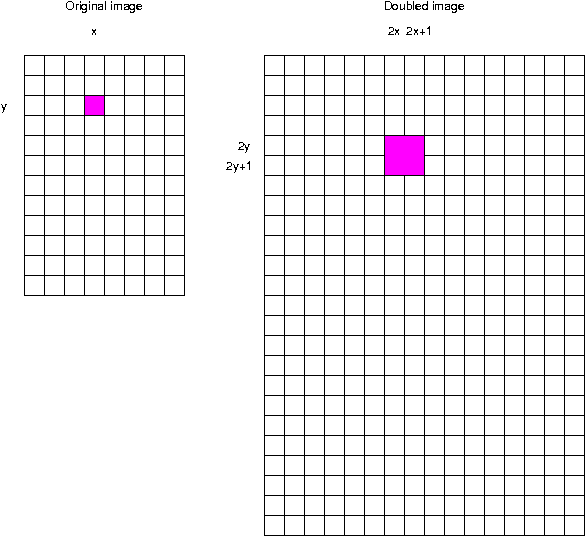In-class notes for 03/03/2014
CS 121B (CS1), Spring 2014
Quiz returned... Wed
Submitted questions on assignments and technology
-
Recall example from last time
-
import cImage as image def negative(img): for row in range(img.getHeight()): for col in range(img.getWidth()): pixel = img.getPixel(col, row) red = pixel[0] green = pixel[1] blue = pixel[2] img.setPixel(col, row, image.Pixel(255-red, 255-green, 255-blue)) return img def main(): win = image.ImageWin() img = image.Image("stomag.png") img.draw(win) # shows the image before modification img = negative(img) img.draw(win) # shows the image after modification img.save("stomag_negative.png") win.exitonclick() main() - The goal for the sepia problem is to compute
new red, green, and blue intensities as
described in the sepia problem.
Images:


Recursion problem 8d -- modifying
drawSprig()import turtle window = turtle.Screen() fred = turtle.Turtle(); def drawSprig(tu, length, factor, angle, colors): if colors != []: prevcolor = tu.pencolor() tu.pencolor(colors[0]) tu.forward(length) tu.left(angle) drawSprig(tu, length*factor, factor, angle, colors[1:]) tu.right(angle) drawSprig(tu, length*factor, factor, angle, colors[1:]) tu.right(angle) drawSprig(tu, length*factor, factor, angle, colors[1:]) tu.left(angle) tu.up() tu.backward(length) tu.down() tu.pencolor(prevcolor) fred.left(30) drawSprig(fred, 100, .5, 40, ['black', 'green', 'blue', 'red'])clear()method forturtle.Screen()objects.
Upcoming
Quiz on Friday this week, instead of Wednesday.
Submitted questions on readings
Image processing
Functions that create new image objects
cImage.EmptyImage- 2 arguments: Non-negative integers
- State change:
- Creates a new
Imageobject with arg1 columns and arg2 rows, all initialized as white pixels. -
Return: That newly constructed
Imageobject
import cImage as image win = image.ImageWin() img = image.EmptyImage(200, 300) img.draw(win) # shows a white image, 200x300 pixelsDoubling the size of an image

Recursion
In-class exercise last time:
Exercise 1: Write a function that counts the number of elements in a list, using recursion
countElements- One argument: A Python3 list
- Return: A non-negative integer, the number of elements in arg1
countElements([1, 'a', 2]) --> 3 countElements([]) --> 0Solution:
def countElements(lis): if lis == []: return 0 # assert: lis is a non-empty list else: return 1 + count_elements(lis[1:])
Problem solving with recursion
Start with a spec. Recursion requires recognizing the same programming goal with smaller data, and a spec clearly states what a function's programming goal may be.
Example:
countElements- One argument: A Python3 list
- Return: A non-negative integer, the number of elements in arg1
countElements([1, 'a', 2]) --> 3 countElements([]) --> 0To find the number of elements in a list
[1, 'a', 2],First, find the number of elements in shorter list
['a', 2]Then, add 1
Syntax for these steps:
Because:1 + countElements(lis[1:])countElements(lis[1:])is the number of elements in the "tail"lis[1:], according to the spec ofcountElements().
Use cases. With list arguments, there are usually at least two cases
Empty list -- typically solved directly, i.e., without using recursion.
Non-empty list -- typically solved using recursion, since we don't know how many elements remain in that list
if/else(for two cases) orif/elif/else(or nestedif, for more than two cases)if lis == []: return ______ # assert: lis is a non-empty list else: ______Write
# assertcomments as you go. These comments describe the logical state at a particular point in the computation, and taking the time to write that helps you focus on what needs to be done at that point.Example:
if lis == []: return ______ # assert: lis is a non-empty list else: ______Note: As in the example above, we will write
# asserts just before the syntax for the next case, to describe what must be true if we get that far.
Recursive functions that return a list
Tracing a list concatenation.
Exercises
Exercise: Write a function that produces a list of doubles of elements in a list of numbers, using recursion
double- One argument: A list of numbers
- Return: A list of numbers, whose elements are twice the corresponding elements of the list arg1
double([4, 7, -1.5]) --> [8, 14, -3.0] double([]) --> []Hints:
Use the concatenation operator
+assemble the answer.As before: use
ifto handle the empty-list case separately; no accumulator; use a slice.
Exercise: Write a function whose return value replaces particular value in a list with another value, using recursion
replace- 3 arguments: Any two Python3 values and any Python3 list
- Return: A list, whose elements are the same as the elements of the list arg3, except with each occurrence of arg1 replaced arg2.
replace ('a', 77, [4, 'a', 1]) --> [4, 77, 1] replace (5, 8, [5, 5, 0, 5, 7]) --> [8, 8, 0, 8, 7] replace (5, 8, []) --> []Hints:
- This problem needs three cases:
- empty list
- first element matches arg1
- first element doesn't match arg1
if/elif/else(or nestedif/elseto program for each case separately As before, use concatenation operator, slice, etc.
Be sure to include the first two arguments in your recursive calls
Upcoming recursion topics
Two other ways to think about recursion (besides problem-solving/specs): patterns; tracing recursion
Stack frames
Recursion with nested lists
Strings
String operators:
[ ](index)[ : ](slice)+(concatenate)*(repeat)==!=<><=>=innot inMay talk about L-systems later
Built-in function
len()len(builtin)- One argument: A list or a string
- Return: A non-negative integer: if arg1 is a list, returns the number of elements in that list; and if arg1 is a string, returns the number of characters in that string.
len([1, 'a', 2]) --> 3 len([1, 'a', [2, 5]]) --> 3 len("apple") --> 5Builtin functions for characters:
chr(),ord()
< >